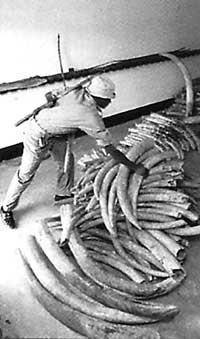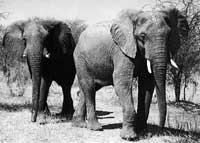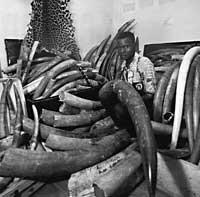Elephants do not fit in Africa's natural parks
2000/10/01 Carton Virto, Eider - Elhuyar Zientzia
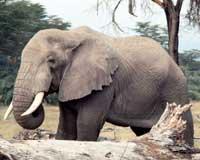
In South Africa's Kruger National Park, they have been trying to solve elephant overpopulation problems for years. In 1967, 600 elephants died to keep the population stable between 7,500 and 8,000 individuals. The murders have been repeated every year since then: first give sedatives and then die to shots. The Elephant family has been murdered in this way. The last one was made in 1994 and finished with 312 fewer elephants.
Insatiable foods
Elephants eat between 18 and 20 hours a day and each can ingest about 250 kilos of grass. Therefore, even though they are essential for the recovery of their ecosystem, too large populations are harmful. Because of the need for food, trees are knocked down before their proper development and forests become meadows. They condition the vegetation of the territory in which they live and, in general, affect biodiversity according to the population. In a very populated region of elephants biodiversity is usually low, but the opposite does not have to be true, that is, where there is little elephant biodiversity is not intentionally or large. Intermediate populations enrich their habitat.
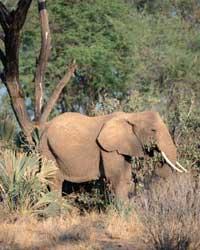
Elephants have always been walkers of wide territories. They traveled hundreds of kilometers before returning to a specific place and thus there was time to recover the native vegetation. Now, by being forced to live in the parks, they have less space to move and, therefore, the ecological pressure they exert is greater. Plants are swallowed faster than growing, as there is not enough for everyone. In the end they will have to deal with the land and face the danger of starving without food. And next to the elephants, also other animals of the park.
When living conditions are adequate, the elephant population can increase by 5% annually, but what is a new joy of conservation becomes a source of problems for limited surface parks. Thus, managers of several African natural parks have considered it necessary to carry out the control of elephants.
Control has been carried out mainly by months of elephants. It is the cheapest method known and also allows to earn money: ivory and leather for the international market and meat for locals. Although they try to use this method as gently as possible, it is impossible to kill elephants without causing suffering. Elephants are very social animals and seem to be aware of the death of their companions and relatives. Therefore, alternatives of population control have been sought.
Transfer and contraception
One option is the transfer of elephant families. This way, overpopulation problems in a region can be solved and new populations can be established simultaneously. In general, from the point of view of the social structure of elephants, it is considered that family transfer is not as traumatic as death, although studies show that animals have a hard time adapting to the new place of residence. To the stress of the transfer must add fear and aggressiveness when arriving. In addition, it is difficult to look for new regions. But the most serious problem, once again, is economic. Special equipment, which is expensive, is required for the capture, transport and disposal of 8 ton elephants. Given that the economic situation in Africa is unfortunate, as a method of control it does not seem that the transfer will have much future.
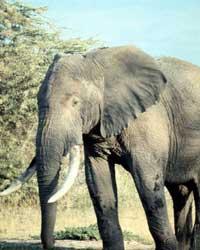
The third option is contraception, that is, stabilization of populations through birth control. This path is being investigated in Kenya and South Africa, specifically in Kruger National Park, where Professor Richard Fayren-Fosten has recently obtained positive results using the immune system of elephant females. The vaccine applied to animals boosts the immune system of females to produce antibodies that prevent fertilization and its effect lasts between 12 and 14 months. To demonstrate the validity of the vaccine, 20 female elephants and many others were not. Six weeks later they received a second dose and the third six months. One year later, 84% of unvaccinated females and 44% of vaccinated females were intended for breeding. It seemed that the vaccine was going this way. To improve the results it was observed that the frequency of the second and third doses was reduced to 2 and 4 weeks and the percentage of children was reduced to 20%.
During the study the treated elephant females have not shown any side effects, physical or social bearing, and have been able to regrow without problems after the effect of the vaccine.
The trials carried out so far by contraception have not been very successful, but it is possible that the latter has not achieved the others. A priori meets all the requirements: it is easy to give, for example through darts launched from helicopters, effective and safe for animals. If the cost is also low, you may have chances to continue.
Overpopulation as an excuse for sale
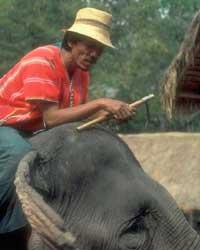
Two years ago 1979 and 1989 the number of African elephants was halved from 1.3 million to more than 600,000. The main reason, of course, is the dental ivory of elephants. In the same year, the nations that established the international ban on trade in ivory, price soared and demand for ivory and illegal hunting fell rapidly. But the ban did not take long to relax and in 1997, due to the overpopulation of elephants in parks, Zimbabwe, Botswana and Namibia allowed restricted trade. For conservation institutions authorization has been the most obvious mistake of the 1990s, as they consider legal transactions to protect the black market. And they seem to have no reason, elephant hunting and the confiscation of illegal ivory have been growing. Last year, for example, the Japanese bought nearly 60 tons of ivory from Zimbabwe, Botswana and Namibia before implementing a detection system that came from legal or illegal killings.
Asia also in danger
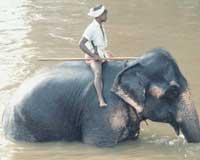
Although for centuries elephants have domesticated and worked in Asia, they have failed to escape the ghost of extinction. According to researchers, less than 50,000 wild elephants live in Asia and their main enemy is habitat loss. Asian elephants are smaller and lighter than Africans and only males have long teeth. Therefore, they are less attractive for hunters looking for ivory. In that sense, at least, they are better than in Africa. As for the habitat, the problems are more serious in Asia, where the human population and their demands for soil are greater. The territory of the Asian elephant, which once began in Syria and Iraq and ended in Borneo, can only be seen in South and Southeast Asia.
Published in the supplement Natura de Gara

Gai honi buruzko eduki gehiago
Elhuyarrek garatutako teknologia




